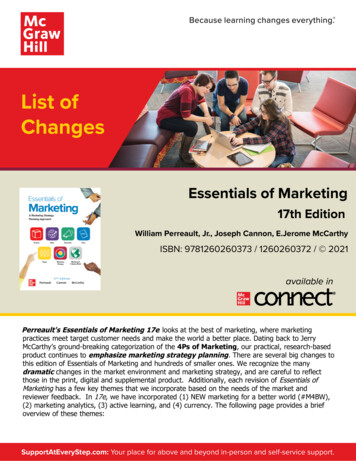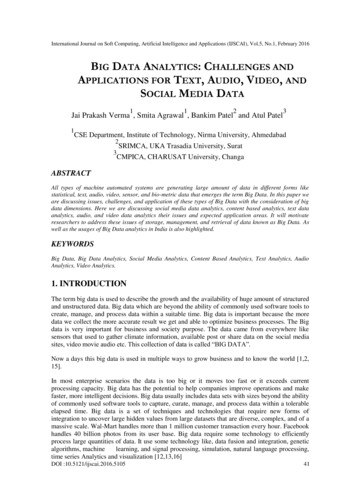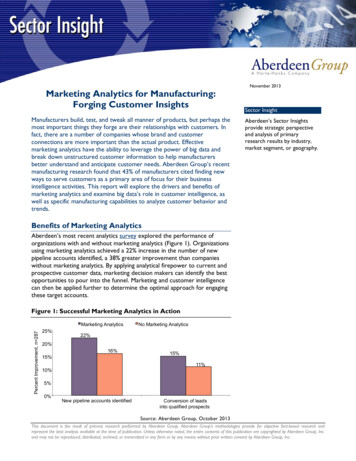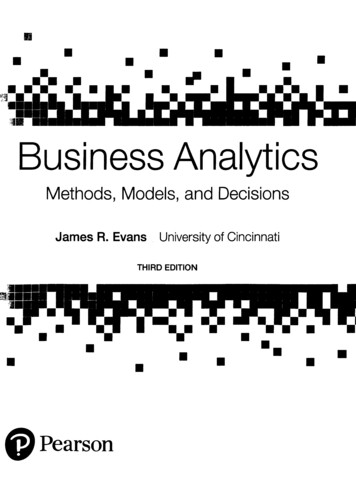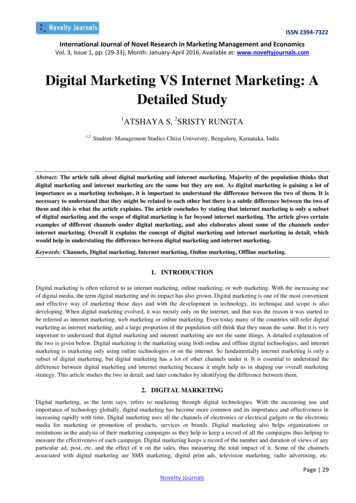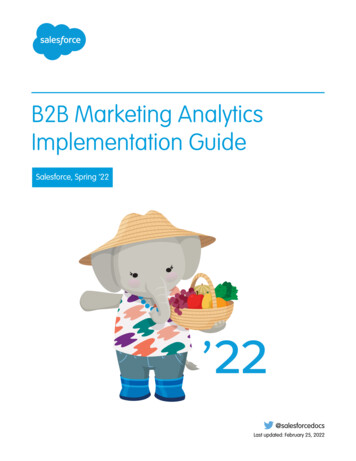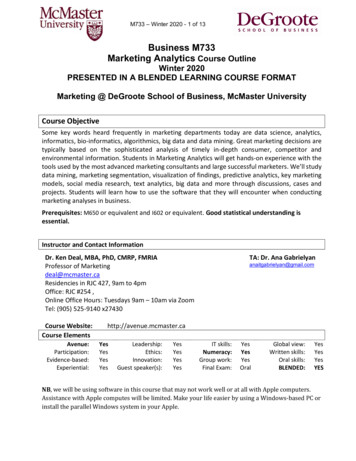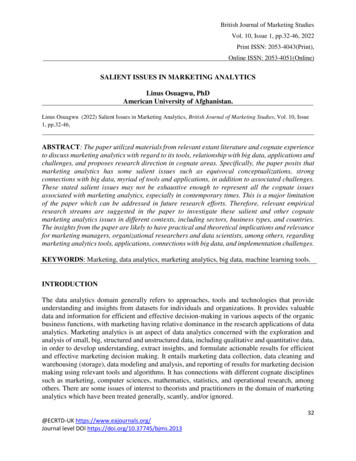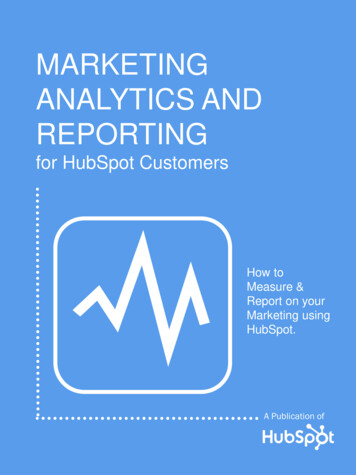
Transcription
MARKETINGANALYTICS ANDREPORTINGfor HubSpot CustomersHow toMeasure &Report on yourMarketing usingHubSpot.A Publication of
2USE WITH THECOMPANIONWORKBOOKGet the most out of this ebook by using it alongside thecompanion workbook.Get the workbook.www.hubspot.com
3IS THIS EBOOK RIGHT FOR ME?Not quite sure if this ebook is right for you? See the below descriptions todetermine if your level matches the content you are about to read.INTRODUCTORYIntroductory content is for customers who are relatively new to theHubSpot software. This content typically includes instructions onhow to get started with this aspect of inbound marketing and learnits fundamentals. After reading it, you will be able to execute basicmarketing tactics related to the topic.INTERMEDIATEThis ebook!Intermediate content is for customers who are familiar with theHubSpot software and have attended the initial HubSpot TrainingClasses. You should have basic experience in executing strategiesand tactics on the topic. This content typically reveals more complexfunctions and explores critical thinking. After reading it, you will feelcomfortable leading projects with this aspect of inbound marketing.ADVANCEDAdvanced content is for customers who are, or want to be, expertson the subject. This content walks you through advanced features ofthis aspect of inbound marketing and helps you develop completemastery of the subject. After reading it, you will feel ready not only toexecute strategies and tactics, but also to teach others how to besuccessful.
4HOW TO USE THIS EBOOKUse this ebook with the companion SLANDINGPAGESCALLS TOACTIONPROSPECTSSOURCESThe workbook guides you through real-lifeexercises in HubSpot so that you canimmediately put what you learn to use.Know the basics: You should be familiar with theHubSpot tools listed to the right.Use consistent date ranges: Measure the samedate range within each chapter.Vary your analysis: Select different items toanalyze within each tool. Avoid selecting the samelanding page for all five landing page exercises ifpossible.Go back in time: You should have at least sixmonths of data in your HubSpot to get the mostout of the ebook.www.hubspot.com
5MARKETING ANALYTICSBy Alan Perlman and Erin McCarthyFOLLOW ME ON TWITTER@ALANPERLMANFOLLOW ME ON TWITTER@ERINMCCARTHwww.hubspot.com
6CONTENTSDETAILED ANALYSIS/9LANDING PAGESKEYWORDSEMAIL/11/13/15CALLS TO ACTIONSOCIAL MEDIAPROSPECTSWORKFLOWS/17/18/20/22PAGE PERFORMANCE/23CAMPAIGN GOALS AND TIMEFRAMESCREATE A MARKETING REPORTwww.hubspot.com/29/25
7Great marketers don’t justreview the numbers - theyunderstand the details thatdrive them.It’s time to put your analytics hat on. Great marketers not only know theirnumbers cold, they understand all of the intimate details and movingparts that drive those numbers. This ebook shows you which detailedmetrics are the right ones to focus on and maps out the ten slides thatresult in a marketing report that you won’t want to live without.Most marketers strive to perfect that report, and rightly so. But reallymastering inbound marketing analytics involves far more than producinga snapshot of current performance. Mastering this requires first steppingback and understanding exactly what drove that performance and whatthe next steps should be.This ebook will take you through each step required to gain thatunderstanding. We’ll start at the beginning – closely inspecting how eachmoving piece is performing. We’ll finish by prioritizing which items needaction first, and we’ll finish by building a marketing report.
8You’ll begin by doing an in-depth analysis of your individual HubSpottools. A quick evaluation of each one can reveal massive opportunities.Use your observations to develop actionable steps that whenimplemented, will result in improved performance.Next, use your data to set priorities and goals using a campaignapproach. Identify which area of your funnel needs the mostlove. This will help you prioritize those actionable steps.Wrap up with your baseline metrics. Build an amazingmarketing report that reveals the big picture andcelebrates success. Complete the previous two sectionsfirst, and it will be easy to present this data in acompelling way and confidently handle questions.
9CHAPTER 1DETAILEDANALYSISANALYZE EACH TOOL FOR QUICK WINS
10Take the temperature andvital signs of your inboundmarketing We’ll begin by diving into the detailedanalytics available in each tool. Wewant to understand how to use thatdata to improve future performance.Doing some simple diagnosis canreveal massive opportunities – pavingthe way for small changes that yield bigimprovements in all areas of yourmarketing funnel. After workingthrough this chapter, you’ll know how totake the temperature and vital signs ofyour inbound marketing and have asolid foundation for building marketingreports and doing campaign analysis.
11Landing PagesLanding PagesLook at individual Landing Pageperformance to find ways toincrease submissions and build asolid Contacts database and salesfunnel. Select a different LandingPage for each section if possible.Are your Landing Pages being viewed? Landing Pages need anaudience. Explore the Landing Pages with the least number of views.Which ones need some additional promotion to get more Contacts?Are your Landing Pages converting? Are visitors taking the nextstep and submitting the form among the Landing Pages that are beingviewed? The average submission rate is 5-15%. Where submission ratesare under 15%, why are people clicking through but not submitting?www.hubspot.com
12Landing PagesDo you have offers aimed at all stages of the buying process?Inventory your content relative to specific stages of the buying process. Ahealthy database is constantly replenishing itself with Contacts who arein all phases of the buying process. Look specifically for a particular areayou’ve been neglecting.Are your landing pages generating new contacts? The averagemarketing list decays by 25% each year and it needs to be constantlyreplenished. Is your new contact rate at least 50% among the landingpages you associated with the early buying cycle stage?Is your content creation engine running smoothly? If each landingpage generates twenty new contacts a month on average, you want tokeep building them. How many offers are you publishing on average eachmonth? Look to publish one new offer per month at minimum.www.hubspot.com
13KeywordsKeywordsExamine your keywords, thenprepare to increase your visits bystrategically focusing on a coregroup. Find different keywords foreach section if possible.Are you tracking and targeting long tail keywords? Find long tailvariations of your short tail keywords. Long tail keywords comprise 70%of search traffic*, and these versions are typically easier to target thantheir short tail counterparts. Plus, more specific terms tend to bring morequalified visitors.Which keywords should be yielding more conversions? It’s criticalto be on top of any chance to increase your website conversions.Keywords that generate visits but not submissions present an easy wayto find those chances. The ranking pages either need a call to action, orone that’s more focused.SEOmozwww.hubspot.com
14KeywordsWhich keywords can rank better with a bit more focus? Findkeywords that are close, but not quite there. Look for keywords where youhave pages ranking in the top ten results. They can rank better with someadditional focus.Are you tracking a wide enough range of keywords? It’s reallyimportant to track a wide range of keywords – you can track up to 1,000of them in the Keywords tool. Tracking a wide sample allows you to seechanges over time, get better recommendations, and use other tools inHubSpot to track these keywords. Having lots of keywords lets you build amore complete tracking history, which presents a better, bigger picture ofyour SEO as a whole.Are you focusing on important keywords?While you want to track data for lots of keywords,you should take action on only a handful at atime. If you’re using the workbook thataccompanies this ebook, the twelve keywordsyou just came up should be a great starting list.www.hubspot.com
15EmailEmailMeasuring email performanceallows you to understand the healthof your Contacts database and therelevance of your content. Selectdifferent emails for each section ifpossible.Are email recipients clicking through? On average, emails have a5.5% click-through rate*. How many of your emails have a click-throughrate that’s under 4%? Anything lower than that indicates that the peoplein your lists aren’t finding your email relevant.What click-through rates are your automated emails getting?These emails are going out on an ongoing basis, which means you havethe chance to improve click-through rates over time. By definition, theseemails should be extremely targeted and should perform even betterthan standard, one-time email sends.*eMarketerwww.hubspot.com
16EmailHow high are your unsubscribe rates?Understand how many – and which - emails havean unsubscribe rate greater than 1%. Howtargeted is the content to the recipient list? Verygeneral emails sent to a large (or to an entire) listtend to perform very low in this area. The morerelevant the email is perceived as being by therecipient, the more clicks it will get.How are your spam report rates? These are even worse for youthan unsubscribes, and can indicate a serious problem with yourdatabase. If your spam rate is over 1% on a consistent basis, take a closelook at where your Contacts are coming from. Spam reports indicate thatyour emails are unexpected, unwanted, and you’re unknown to therecipient.Are the emails you send on a recurring basis trending well? Foremails sent on a schedule, such as newsletters, measure the clickthrough rate and lost Contacts rate over time.www.hubspot.com
17Calls to ActionCalls to ActionImproving calls to action will yieldincreased clicks and submissions.Without a good call to action,visitors will never even get to thelanding pages. Pick different calls toaction for each section if possible.Which calls to action aren’t being seen? How many pages andemails are your least-viewed calls to action located on? Also look to theclick-to-submission rate; promoting a call to action when the landingpage is performing well is a no-brainer.Which calls to action have low click-through rates? These calls toaction are getting views, but not clicks. What is it about them that’s notstriking a chord?Are visitors following through with submissions? Low click—tosubmission rates indicate that the call to action isn’t tightly aligned withwhat visitors see on the landing page.www.hubspot.com
18Social MediaSocial MediaWhile measuring visits, leads, andcustomers generated from socialmedia are the best metrics, activityand engagement levels drive thosenumbers.Are you growing your audience over time? Growing fans andfollowers is the first step to generating visits and submissions from socialmedia. You’ll also want to know which channels are yielding the bestgrowth.Are you consistently engaging your followers? It won’t matter howlarge your audience is if you’re not posting regularly. While the rightfrequency depends on a number of factors, you should update at least afew times a week.www.hubspot.com
19Social MediaIs your content relevant? How often are people engaging with thethings you are posting? Look for comments, likes, favorites and such.This is a good measure of how relevant the content you’re posting is tothe target audience you have on each social media channel. Knowing thiscan help you know what they like for the future. And knowing whichchannels yield the most and least engagement can help you understandwhere your best prospects are.Are people clicking through?Knowing which content generatesthe most clicks is a great way tomeasure how remarkable yourcontent is. Driving traffic to your siteleads to the visits and conversions you’re ultimately looking for. Knowingwhat type of content is clicked on the most can help you do more of whatactually works. Don’t forget to analyze by channel as well – the contentthat LinkedIn users find remarkable might be quite different than thecontent that Facebook users find remarkable.www.hubspot.com
20Prospectsprofessional and enterprise onlyProspectsFind ways to turn visitors fromspecific companies in your databaseto Contacts and help your salesteam understand who’s engaged.Find different prospects to target foreach section if possible.Which companies need just a bit more coaxing? Look for acompany you could more actively solicit to become a new contact. Theyare interested, but haven’t quite bitten yet. Find companies with a highnumber of visits but no submissions. Knowing what pages they viewed,how they found you, and what keywords they typed in should give youideas for content that’s custom made just for them.Can you spot any existing customers? Keep an eye out for existingcustomers in Prospects. If you recognize any, drill into the details. Findout where their interests lie and who from the company is looking. If itlooks like there might be upsell opportunity, involve sales.www.hubspot.com
21ProspectsAre there companies in the listthat are already engaged in the salesprocess? Is there a company lurking inyour visitors that you would just love tohave as a customer, or have evenalready been courting? Sales should beaware of the activity.Who has high levels of activity? Drill into that company and look atthe pages viewed and if there were any contacts that have converted.These companies are interested even though they haven’t yet converted.Make sure sales is aware of these companies, what they’re looking atand searching for, and which contacts from that company are activelyinterested.See any trends? You might see surprising patterns in industry orcompany types interested in your site. Knowing that you’re generatingwithin these specific groups can help you think about your content from anew perspective.www.hubspot.com
22WorkflowsWorkflowsUnlike one-time email sends,automated emails can be tweakedto improve performance becausethey’re going out on an ongoingbasis. Find a different workflow totarget for each section if possible.How many Contacts are you losing? Automated emails are basedon an action, and should be highly relevant. Evaluate how relevant yourcontacts think they are. How many are unsubscribing or marking theemails as spam?Are there emails within the workflow that aren’t performing aswell as the others? Look at the workflow steps to find any major dips inengagement. While it’s natural for engagement to dip at each step, lookfor big plunges in email performance that are out of place with the rest ofthe graph. These emails likely have content that contacts enrolled in theworkflow don’t find relevant, or the email comes too soon after the onebefore it.www.hubspot.com
23Page PerformancePage PerformanceLearn how your individual pages andblog posts are performing. Manysuggestions in this report can havea big impact.On what pages can you increase submissions? Check your mostviewed pages for little or no conversion rates. Adding a call to actionthat’s relevant to the keywords bringing visitors can make a world ofdifference.What general SEO improvements can you make? Scan your list ofpages for suggestions and errors. Tread with caution, though – don’tchange what’s working but rather supplement by populating missinginformation. And be sure you understand exactly which keyword eachpage is targeting before doing so. Of course, if the page in question isn’tgetting visits or is just plainly optimized wrong, replace away.www.hubspot.com
24Page PerformanceWhich successful blogging trends can you repeat? When it comesto bringing traffic to your site, blog posts are gold. You need to know whatyou’re doing right so you can do more of it. Why are your most visitedposts so popular? Is there a particular author or guest blogger that doesreally well? Is there a trendy or controversial topic that’s netting lots ofvisits? A particular keyword you’re using that’s working really well?Identifying these trends helps you work them into your content strategy.www.hubspot.com
25CHAPTER 2CAMPAIGNGOALS ANDTIMEFRAMESPRIORITIZE AND FOCUS
26Campaign Goals and TimeframesKnow if contacts areprogressing through thefunnel and where they’restalling.Do you know if you should be runninga visits, leads, or customerscampaign? While inbound marketingcalls for focus in all of these areas,being able to easily prioritize isextremely helpful. Even if you’re notplanning on changing your focus, youstill need to know if contacts areprogressing through your marketingfunnel and where they’re stalling.
27Campaign Goals and TimeframesCampaign Goal Setting and TimeframesWhat does your marketing funnel look like today? Knowing where yourfunnel needs help allows you to set a visits, leads, or customerscampaign goal and focus specific activities around that goal. To set theright campaign goal and a reasonable deadline to accomplish it in, you’llneed to know where your funnel needs the most improvement, why thatarea is a challenge, and how much the numbers need to change to get itwhere it needs to be.What’s causingthe gap?www.hubspot.com
28Campaign Goals and TimeframesYour sources data is the key to analyzing the marketing funnel. Mostbusinesses should see between 2-4% visit to contact conversion rate,and a 1-2% contact to customer rate. You can see in the example below avisit-to-contact rate that’s quite low, so this marketer should focus on aleads campaign.If your other numbers look healthy but your visits aren’t increasingmonth-over-month, you should run a visits campaign.www.hubspot.com
29CHAPTER 3CREATE AMARKETINGREPORT10 SLIDES THAT CELEBRATE YOUR WINS
30Marketing ReportStop analyzing and startcelebrating with a killermarketing report.As long as marketing has existed,marketers have struggled to prove theirimpact. By now, you are probably morethan ready for the logical conclusion creating a marketing report that doesjust that. Here are ten slides to buildusing HubSpot data that demonstrateROI and show the rest of yourorganization the value you bring. Oneach slide, bring focus to yourachievements by adding a bulletsummarizing what you did to get there.If you’ve done your tool-by-tool andcampaign analysis, you already knowthe exact activity to talk about whenpresenting these results to your team.
31Marketing ReportVisits by source. On your sources chart by visits, what is thegreatest improvement you see over time? What did you do to getit there?Top ten blog posts by page views. Why are these your top ten?Add one bullet discussing how you accomplished this.Marketing grade vs. competitors. Identify a trend and explain iton a bullet in your slide.# of indexed pages vs. competitors. Talk about all of theeffective content you’ve been creating.# of linking domains vs. competitors. Talk about all of therelevant promotion you’ve been doing, whether through socialmedia or other channels.www.hubspot.com
32Marketing ReportContacts by source. Which source is generating the mostcontacts? Talk about your best landing pages and where you’repromoting them.Top ten landing pages by submissions. Talk about why youroffers are resonating and why they’re so useful.Paid vs. organic contacts. Talk about the content you’re creatingto divert traffic from paid keywords to organic ones.Customers by source. Talk about the work you’re doing topromote your best content out to that source.Top ten landing pages by customers. Why are these your topten? Talk about the why the offers bring in qualified leads thatturn into customers.www.hubspot.com
33Marketing ReportEXTRA-CREDIT REPORTING IDEASNumber of leads sales worked. How many of the leads yougenerated through inbound marketing did sales contact?Top ten landing pages by customers. Why are they your topten?Paid vs. organic contacts. What efforts are you putting in fororganic?www.hubspot.com
34A 360 degree view of yourinbound marketing makesbuilding a marketing reportmuch easier.You’ve now read through the ebook and completed the workbookalongside it. You’ve put together your next steps based on an in depthevaluation and built a marketing report. You can go ahead and take thatanalytics hat off now. Good work!Mastering the art of inbound marketing analytics isn’t just about buildingslides. The truly great slides are the ones that demonstrate greatperformance. To get to that level of performance, you need to be able toperform a detailed analysis, use the information to build actionablesteps, prioritize them, and take action on them.That 360 degree view of your inbound marketing makes building amarketing report much easier. Without it, a marketing report can be quiteoverwhelming.Congratulations – you’ve now mastered the art of reporting on yourinbound marketing. Happy analyzing!
35ASK THEPROFESSORQuestions? Ask HubSpot Professor Alan Perlmanvia email or by attending the live class.Ask the ProfessorAttend the liveworkshopwww.hubspot.com
36GET ON-SITEPROFESSIONALSERVICESWork with an expert consultant to take your inboundmarketing to the next level.Learn more about on-siteserviceswww.hubspot.com
marketing analytics by alan perlman and erin mccarthy follow me on twitter @alanperlman www.hubspot.com follow me on twitter @erinmccarth . 6 detailed analysis /9 landing pages /11 keywords /13 email /15 calls to action /17 social media

